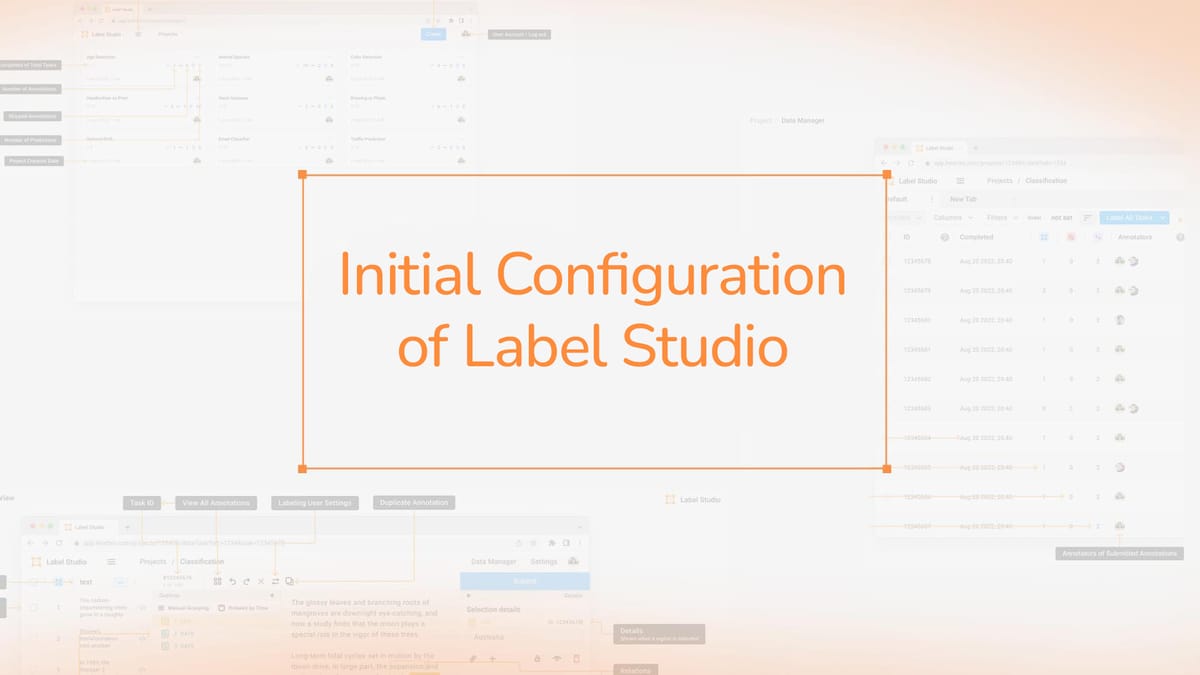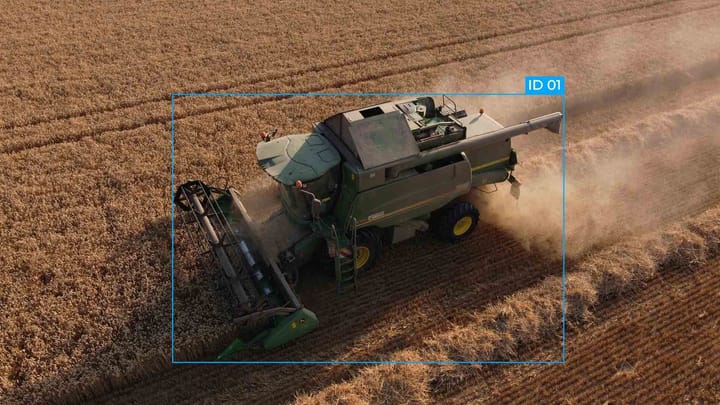Initial Configuration of Label Studio

Upon launching Label Studio for the first time, it employs an SQLite database for storing labeling tasks and annotations. This default setup is suitable for smaller projects. However, for larger projects, switching to PostgreSQL can enhance performance and scalability.
The command line provides numerous arguments to personalize your Label Studio experience. You can select machine learning backends, set the web server port, adjust log levels, and enable debug mode. These options enable detailed control over your labeling environment.
Environment variables are pivotal in configuring Label Studio. Based on your operating system, you can adjust these variables to suit your needs. This adaptability ensures a setup that matches your project's requirements precisely.
Key Takeaways
- Label Studio uses SQLite by default for data storage
- Command line arguments offer extensive customization options
- Environment variables can be set for specific configurations
- Multiple installation methods are available (pip, Docker, Ubuntu, Anaconda)
- Label Studio supports various data types for annotation
- Consider alternatives like Labellerr for advanced features
Understanding Label Studio and Its Importance
Label Studio is a crucial tool for annotating data, essential in machine learning workflows. It supports annotating text, audio, images, and video. Let's delve into what Label Studio offers and its significance for data labeling.
Key Features and Benefits
Label Studio stands out for its numerous benefits in data annotation:
- Support for multiple data types
- User-friendly interface
- Integration with machine learning models
- Flexible data import options
- Enterprise-grade security features
| Feature | Benefit |
|---|---|
| Multi-data type support | Annotate text, audio, images, and video in one platform |
| ML model integration | Predict labels at various stages of the labeling process |
| Cloud storage connection | Enhanced security and convenience for data import |
| Enterprise cloud service | SSO, RBAC, and SOC2 compliance for advanced security |
Label Studio simplifies the data annotation process. This leads to better quality in machine learning models and boosts workflow efficiency.
Prerequisites for Label Studio Installation
Before starting the Label Studio installation, ensure you meet the necessary requirements. These include both hardware and software components crucial for smooth operation.
Your system should have at least 8GB of RAM, with 16GB recommended for better performance. Disk space is also vital. Label Studio requires about 50GB for production instances. To illustrate, 1 million labeling tasks occupy roughly 2.3GB using an SQLite database.
On the software side, Label Studio supports PostgreSQL 11.5 or SQLite 3.35 and above. Python 3.8 or later is essential for pip installation. For Docker installation, ensure your machine has the latest version installed.
Understanding the command-line interface is crucial for Label Studio setup and management. This knowledge aids in navigating the installation process and managing projects effectively.
| Requirement | Specification |
|---|---|
| RAM | 8GB (minimum), 16GB (recommended) |
| Disk Space | 50GB (recommended for production) |
| Database | PostgreSQL 11.5+ or SQLite 3.35+ |
| Python Version | 3.8 or later |
| Docker | Latest version |
With these prerequisites fulfilled, you're prepared to move forward with Label Studio installation. You can choose from pip, Docker, or other methods based on your system setup.
Installation Methods for Label Studio
Label Studio installation offers various options to meet your needs. You can opt for Docker setup, pip install Label Studio, Ubuntu installation, or Anaconda setup. Each method caters to different skill levels and system configurations, offering unique advantages.
Docker Installation
Docker setup is a favored choice for installing Label Studio. It ensures isolation and facilitates easy deployment. To initiate, execute this command:
docker run -it -p 8080:8080 -v `pwd`/mydata:/label-studio/data heartexlabs/label-studio:latest
This command downloads the latest version, making the interface accessible at http://localhost:8080. Docker setup guarantees consistent environments across various systems.
Pip Installation
For Python enthusiasts, installing Label Studio via pip is straightforward. It seamlessly integrates with existing Python projects. Simply use this command:
pip install label-studio
Post-installation, launch Label Studio by entering 'label-studio' in your terminal.
Ubuntu Installation
Ubuntu users can directly install Label Studio on their systems. Begin by updating your package list:
sudo apt-get update
Next, install Label Studio:
sudo apt-get install label-studio
Anaconda Installation
Anaconda users can establish a dedicated environment for Label Studio. Execute these commands:
conda create --name labelstudio python=3.8 conda activate labelstudio pip install label-studio
This approach facilitates effortless dependency management. The Label Studio frontend is integrated into the installation, obviating the need for additional setup.
| Installation Method | Advantages | Best For |
|---|---|---|
| Docker | Isolation, Easy deployment | Consistent environments |
| Pip | Simple, Python integration | Python projects |
| Ubuntu | Direct system installation | Ubuntu users |
| Anaconda | Environment management | Data scientists |
Configuration of Label Studio
Setting up Label Studio requires several critical steps for smooth operation. This includes Label Studio database setup, environment variables configuration, and server customization. Let's explore each step to efficiently launch your labeling project.
Setting up the database
By default, Label Studio employs SQLite, ideal for small projects. However, for larger endeavors, PostgreSQL might be necessary. Here's the process to set it up:
- Install PostgreSQL on your system
- Create a new database for Label Studio
- Set the necessary environment variables
Configuring environment variables
Environment variables are vital for Label Studio's database setup. For PostgreSQL, you must configure these variables:
- DJANGO_DB
- POSTGRE_NAME
- POSTGRE_USER
- POSTGRE_PASSWORD
- POSTGRE_PORT
- POSTGRE_HOST
Customizing server settings
Customize server settings using command-line arguments or environment variables. Key settings include:
| Setting | Description | Default |
|---|---|---|
| Port | Server port number | 8080 |
| Host | Server host address | 0.0.0.0 |
| Debug mode | Enable for development | Off |
Proper configuration of Label Studio's server is crucial for optimal performance. Ensure to adjust these settings according to your project's unique requirements.
"Configuring Label Studio correctly sets the foundation for efficient data labeling and annotation workflows."
Setting Up Your First Project in Label Studio
Creating a Label Studio project is the initial step in your data labeling journey. First, log in and go to the Projects Page. Then, click the "Create" button to start your project setup. This is vital for organizing your data labeling tasks.
When setting up your data labeling project, you must provide key details. Name your project with a title that describes it and add a brief description. This makes it clear to team members what the project aims to achieve.
Importing data is the next crucial step in preparing your dataset for annotation. Label Studio accepts various file formats, making it adaptable for different data types. You can upload a CSV file or connect to cloud storage for bigger datasets.
When importing a CSV file, choose the "Treat CSV/TSV as List of tasks" option. This ensures each line in your CSV is treated as a separate data item for labeling. This method simplifies the annotation process, allowing for more efficient task completion.
- Choose a descriptive project name
- Add a clear project description
- Import data from files or cloud storage
- Configure CSV import settings for optimal task creation
By following these steps, you'll have successfully set up your first project in Label Studio. This sets the stage for efficient data labeling and annotation tasks.
Data Import and Management in Label Studio
Label Studio's data import and management are essential for effective data preparation. It supports a variety of data types, making it adaptable for various machine learning projects. Let's delve into the key aspects of handling data in Label Studio.
Supported Data Types
Label Studio accommodates a broad spectrum of data formats, catering to diverse project requirements:
- Text files
- Audio recordings
- Image files
- Video content
- Time series data
Importing Data from Various Sources
Label Studio provides flexible data import options:
- Direct upload from local storage
- Cloud storage integration (recommended for large projects)
- API-based import for automated workflows
The Data Manager in Label Studio Community Edition acts as the central hub for data management. It displays each row as a labeling task, facilitating easy organization and tracking.
Best Practices for Data Preparation
To ensure efficient data management and preparation in Label Studio:
- Clean and format your data before import
- Use cloud storage for large datasets to improve efficiency
- Leverage filtering and sorting to organize tasks effectively
- Create tabs to split datasets for different annotators
- Regularly check data validity and accuracy
| Feature | Description | Benefit |
|---|---|---|
| Task Sampling | Customizable order of task presentation | Optimized labeling workflow |
| Data Filtering | Split data based on specific criteria | Focused annotation process |
| Tabs | Organize data by status or annotator | Improved task allocation |
Adhering to these guidelines can streamline your Label Studio data import and preparation, leading to more efficient data management and superior annotations for your machine learning endeavors.
Configuring Labeling Interface and Tasks
Label Studio provides robust tools for labeling task setup and interface customization. It allows you to adjust your labeling environment to suit your project's specific requirements. Whether you're tackling image classification, text annotation, or audio transcription, Label Studio offers flexibility in tailoring your workspace.
To start configuring your Label Studio interface, pick or create a template that fits your project's objectives. You can tweak label names and select colors to boost visual clarity. The platform's labeling process is designed to be project-based, ensuring a tailored setup for each task.
Label Studio version 1.0.0 introduces new callback names for annotation management:
- onSubmitAnnotation
- onUpdateAnnotation
- onDeleteAnnotation
These callbacks offer greater control over the annotation process. When initializing a Label Studio instance, you can specify interface options like panel, update, submit, skip, and controls. This customization ensures your labeling environment is optimized for efficiency and precision.
For advanced users, Label Studio offers further customization through XML configuration files. You can employ Object, Control, and Visual tags to define data types, annotation methods, and interface design. The platform also provides autocomplete functionality in the code view, making customization more accessible.
Label Studio's flexibility in interface configuration and labeling task setup empowers users to create tailored annotation environments, boosting productivity and accuracy in data labeling projects.
Advanced Configuration Options
Label Studio's advanced features provide robust tools to enhance your data labeling workflow. You can refine your projects with machine learning integration, user management, and custom annotation interfaces.
Integrating Machine Learning Models
Label Studio supports machine learning integration to streamline your labeling process. You can link pre-trained models for pre-labeling or active learning. This accelerates annotation and enhances accuracy.
Setting Up User Roles and Permissions
Effective user management is crucial for collaborative projects. Label Studio enables you to define roles and set permissions for team members. This ensures data security and enhances workflow management efficiency.
Customizing the Annotation Interface
Customize the labeling interface to meet your specific needs. Label Studio offers flexible configuration options to optimize the annotation experience. You can tailor tags, layout, and controls for various data types.
| Feature | Description | Benefit |
|---|---|---|
| Choices Tag | Versatile tag for classification tasks | Supports single and multi-class labeling |
| Inline Display | Show choices on the same visual line | Improves annotation interface layout |
| Validation | Ensure required choices are selected | Maintains data quality and completeness |
| Region-specific Choices | Select choices for specific image regions | Enables detailed object annotation |
By utilizing these Label Studio advanced features, you can establish a powerful and efficient data labeling environment tailored to your project's unique requirements.
Conclusion
Label Studio emerges as a pivotal tool for data labeling, significantly enhancing machine learning workflows. Its compatibility spans a wide range of ML and AI projects, including image annotation, making it indispensable for various data science endeavors.
The platform boasts a broad array of annotation tools, such as bounding boxes, polygons, and points, which elevate data labeling efficiency across multiple data types. Its intuitive interface empowers users to craft projects and specify annotation tasks with minimal technical expertise, simplifying the labeling endeavor. This streamlined process, coupled with robust collaboration tools, enhances annotation quality and consistency, vital for ML model efficacy.
FAQ
What is Label Studio?
Label Studio is an open-source tool designed for labeling various data types. This includes text, audio, images, videos, and time series data. It's vital for machine learning, ensuring accurate data labeling for model training and evaluation.
How do I install Label Studio?
Installing Label Studio is flexible, with options like Docker, pip, Ubuntu, and Anaconda. Docker is the recommended method for its ease of setup and isolation. For Docker installation, execute the command "docker run -it -p 8080:8080 -v `pwd`/mydata:/label-studio/data heartexlabs/label-studio:latest".
What database does Label Studio use?
By default, Label Studio employs SQLite. However, it can be adapted for larger projects using PostgreSQL. To switch to PostgreSQL, set variables such as DJANGO_DB, POSTGRE_NAME, POSTGRE_USER, POSTGRE_PASSWORD, POSTGRE_PORT, and POSTGRE_HOST.
How do I create a new project in Label Studio?
Creating a new project in Label Studio involves logging into the interface and clicking the "Create" button on the Projects Page. Name your project and add a description. Then, in the "Data Import" tab, upload files or connect to cloud storage.
What data types does Label Studio support?
Label Studio supports a variety of data types including text, audio, images, videos, and time series data. You can import data directly or from cloud storage.
Can I customize the labeling interface in Label Studio?
Yes, Label Studio allows for customization of the labeling interface to meet project-specific needs. Users can set up different labeling tasks, like text classification, image annotation, or audio transcription. The interface can be customized to display relevant information and offer suitable labeling options for each task.
Can Label Studio integrate with machine learning models?
Yes, Label Studio provides advanced configuration options, including integration with machine learning models. This facilitates pre-labeling or active learning.



Comments ()